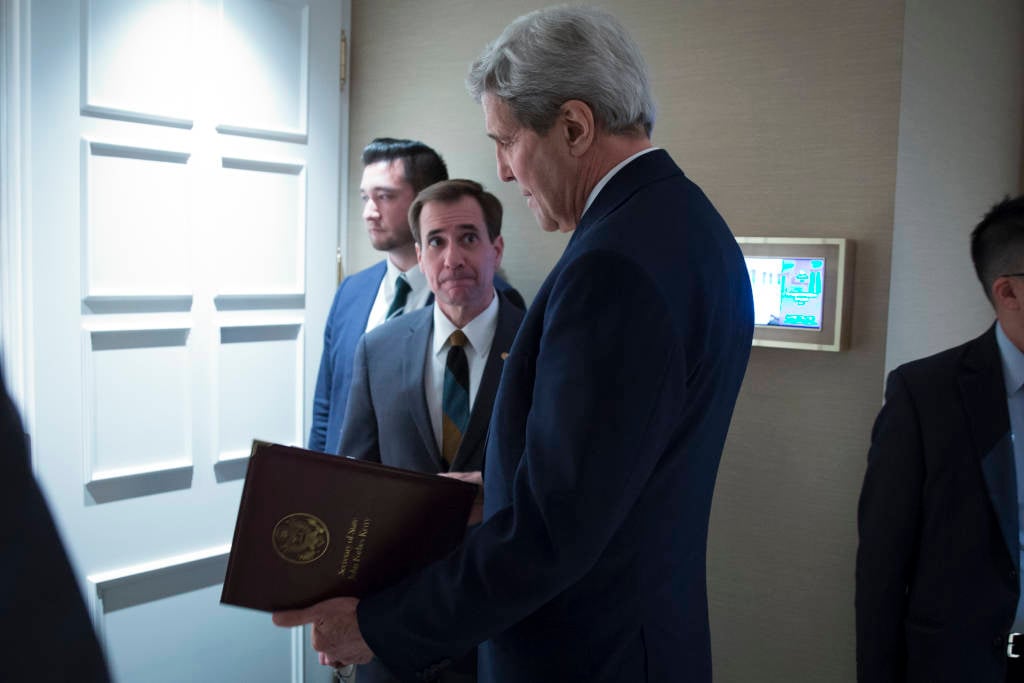A $400 million cash delivery to Iran to repay a decades-old arbitration claim may be unprecedented in recent US history, according to legal experts and diplomatic historians, raising further questions about a payment timed to help free four American prisoners in Iran.
The money was sent to Iran on Jan. 17, the same day Iran agreed to release the prisoners. The Obama administration claimed for months the events were separate, but recently acknowledged the cash was used as leverage until the Americans were allowed to leave Iran. Only then, did the US allow a plane with euros, Swiss francs and other foreign currency loaded on pallets to take off in the other direction for Tehran.
“There’s actually not anything particularly unusual about the mechanism for this transaction,” White House press secretary Josh Earnest said this week of the initial cash payment.
But diplomatic historians and lawyers with expertise in international arbitration struggled to find any similar examples.
Asked to recall a similar payment of the U.S. using cash or hard money to settle an international dispute, the office of the State Department historian couldn’t provide an example.
The acknowledgement that the prisoners and the payment were linked, and the unusual cash delivery, have fueled Republican claims that a “ransom” was paid. At a news conference this month, President Barack Obama said cash was used because the US and Iran don’t have a banking relationship after years of US sanctions on Iran, making a check or wire transfer impossible.
The $400 million was the principal owed by the US on a 1970s Iranian account for buying U.S. military equipment. After Iran’s 1979 overthrow of the US-backed shah and the US Embassy hostage crisis in Tehran, the weapons were never delivered. Iran has wanted the money back plus interest ever since. Seven months ago, two sides put the matter to rest with a $1.7 billion settlement.
Alan Henrikson, diplomatic history professor at the Fletcher School of Law and Diplomacy, Tufts University, found a precedent by reaching back to the 1848 Treaty of Guadelupe Hidalgo that ended the Mexican-American War.
The accord called for the United States to pay Mexico $15 million, an amount worth about $482 million in today’s money, he said. The payment was determined “in consideration of the extension acquired by the boundaries of the United States,” vague diplomatic wording designed to compensate Mexico for a massive loss of territory that included all of California and parts of seven other states. At the same time, the Americans avoided any acceptance of national guilt.
The treaty stipulated that the U.S. immediately pay $3 million — or nearly $100 million in 2016 dollars — in Mexico City in the form of Mexico’s gold or silver coin. The remainder had to be paid the same way in $3 million installments each year, with the debt subject to a fixed rate of 6 percent annual interest. President Ulysses S. Grant would later declare it “conscience money.”
“Ambiguity is often needed in diplomacy in order to achieve agreement,” Henrikson said. “What is important, in my view, is that both sides to a negotiation clearly understand, even if only tacitly, what is being agreed upon when ambiguity is used. This is not all that subtle, actually. It is life.”
The administration has been ambiguous from the start about its settlement seven months ago. Reports by the Wall Street Journal have led to recent acknowledgements about the $400 million delivered in stacks of cash and the connection to the American prisoners. But officials still won’t say how Iran received the $1.3 billion in interest.
It was done “in a fairly above-board way,” a senior administration official intimately involved in the Iran negotiations said in a conference call last week, saying only that the interest payments involved an unidentified, foreign central bank. The official wasn’t authorized to be quoted by name and demanded anonymity. The State Department said Wednesday the payments were made Jan. 19, two days after the cash delivery.
Other settlements with Iran and other foreign claimants in recent decades bore some similarities to this latest transaction. But none seemed to involve planeloads of cash.
In 1996, President Bill Clinton reached a settlement with Iran over the US Navy’s 1988 downing of an Iran Air passenger plane that killed 290 people.
The arrangement totaled $131.8 million but there was no cash delivery. Instead, $61 million was deposited in a Swiss bank account that was jointly held by the New York Federal Reserve and the Iranian Central Bank. The money was reserved for the families of those killed, not the Iranian government. The remainder of the settlement was mainly used to cover Iranian debts to U.S. claimants in separate arbitration cases.
And in 1998, the U.S. settled a dispute with Pakistan after halting the delivery of an F-16 aircraft purchase. The compensation was described as $325 million in cash and $140 million in surplus agricultural commodities, mainly wheat and soy, but the precise mechanics of the payment were never spelled out.
“There were no sanctions regarding dollars or banks in Pakistan, so it may have been that the ‘cash payment’ was a bank transfer,” said Marcia Wiss, an international lawyer with a private practice in Washington.
By: Bradley Klapper, AP
Do You Love Israel? Make a Donation - Show Your Support!
Donate to vital charities that help protect Israeli citizens and inspire millions around the world to support Israel too!
Now more than ever, Israel needs your help to fight and win the war -- including on the battlefield of public opinion.
Antisemitism, anti-Israel bias and boycotts are out of control. Israel's enemies are inciting terror and violence against innocent Israelis and Jews around the world. Help us fight back!
